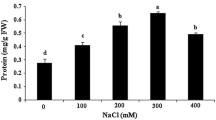Abstract
A selected Glycine max (L.) salt-tolerant calluscell line (R100) was significantly more tolerant to salt than a salt-sensitiveline (S100) during exposure to salt stress. Growth (Fresh and Dry weights) ofthe R100 cell line declined significantly at NaCl concentrations greater than 75mM, while growth of the S100 cell line was already impaired at 25mM NaCl. Levels of Na+ and Cl− inthe callus were elevated as the salt concentration increased, whileK+, Ca2+ and Mg2+ levels weremarkedly reduced. The lower Ψs reduction and Na+accumulation found in the S100 callus corresponded with the higher callusdehydration during salinity. Calli grown on Miller's basal medium weresupplied with 100 mM NaCl for 12 days and then supplied with mediumwithout NaCl to relieve salinity stress. The Na+ andCl− content decreased in both R100 and S100 cell lines duringthe first 24 h and reached normal levels four days after transferto the normal medium. This lower concentration was maintained until the end ofthe experiment. Concurrently, the K+ content andK+/Na+ ratio increased sharply and reached theirhighest levels within 24 h in both salt-sensitive and salt-tolerantcell lines. These data suggest that the inhibitory effects of salinization ongrowth and accumulation of potentially toxic ions (Na+,Cl−) can be readily reversed when salinity is relieved.
Similar content being viewed by others
References
Alarcón J.J., Sánchez-Blanco M.J., Bolarín M.C. and Torrecillas A. 1993. Water relations and osmotic adjustment in Lycopersicon esculentum and L. pennellii during short-term salt exposure and recovery. Physiol. Plant. 89: 441–447.
Flowers T.J., Troke P.F. and Yeo A.R. 1977. The mechanisms of salt tolerance in halophytes. Annu. Rev. Plant Physiol. 28: 89–121.
Flowers T.J. and Läuchli A. 1983. Sodium versus potassium: substitution and compartmentation. In: Läuchli A. and Pirson A. (eds), Encyclopedia of Plant Physiology 158. Inorganic plant nutrition. Springer, Berlin, pp. 651–681.
Galiba G. and Erdei L. 1986. Dependence of wheat callus growth, differentiation and mineral content on carbohydrate supply. Plant Sci. 45: 65–70.
Gates C.T. 1955. The response of young tomato plants to brief periods of water shortage. Aus. J. Biol. Sci. 8: 196–214.
Graifenberg A., Giustiniani L., Temperini O. and Lipucci di Paola M. 1995. Allocation of Na, Cl, K and Ca within plant tissue in globe artichoke (Cynara scolimus L.) under saline-sodic conditions. Sci. Hortic. 63: 1–10.
Greenway H. and Munns R. 1980. Mechanisms of salt tolerance in nonhalophytes. Annu. Rev. Plant Physiol. 31: 149–190.
Kameli A. and Lösel D.M. 1993. Carbohydrates and water status in wheat plants under water stress. New Phytol. 125: 609–614.
Kameli A. and Lösel D.M. 1995. Contribution of sugars and other solutes to osmotic adjustment in wheat leaves under water stress. J. Plant Physiol. 145: 363–366.
Kameli A. and Lösel D.M. 1996. Growth and sugar accumulation in durum wheat plants under water stress. New Phytol. 132: 57–62.
Kennedy B.F. and de Filippis L.F. 1999. Physiological and oxidative response to NaCl of the salt tolerant Grevillea ilicifolia and the salt sensitive Grevillea arenaria. J. Plant Physiol. 155: 746–754.
Kuiper P.J.C., Kuiper D. and Schuit J. 1988. Root functioning under stress conditions: An introduction. Plant Soil. 111: 249–253.
Liu T., van Staden J. and Cress W.A. 2000. Salinity induced nuclear and DNA degradation in meristematic cells of soybean (Glycine max (L.)) roots. Plant Growth Regul. 30: 49–54.
Liu T. and van Staden J. 2000. Selection and characterization of sodium chloride-tolerant callus of Glycine max (L.) Merr cv. Acme. Plant Growth Regul. 31: 195–207.
Locy R.D., Chang C.C., Nielson B.L. and Singh N.K. 1996. Photosynthesis in salt-adapted heterotrophic tobacco cells and regenerated plants. Plant Physiol. 110: 321–328.
Maathuis F.J.M. and Amtmann A. 1999. K+ nutrition and Na+ toxicity: the basis of cellular K+/Na+ ratios. Ann. Bot. 84: 123–133.
Miller C.O. 1965. Evidence for the natural occurrence of zeatin and derivatives: Compounds from maize which promote cell division. Proc. Natl. Acad. Sci. USA. 54: 1052–1058.
Munns R., Greenway H. and Kirst G.O. 1983. Halotolerant eukaryotes. In: Lange O.L., Nobel P.S., Osmond C.B. and Ziegler H. (eds), Encyclopedia of Plant Physiology. 12C. New Series. Springer-Verlag, New York, NY, pp. 59–135.
Pardossi A., Malorgio F., Oriolo D., Gucci R., Serra G. and Tognoni F. 1998. Water relations and osmotic adjustment in Apium graveolens during long-term NaCl stress and subsequent relief. Physiol. Plant. 102: 369–376.
Rus A.M., Panoff M., Perez-Alfocea F. and Bolarin M.C. 1999. NaCl responses in tomato calli and whole plants. J. Plant Physiol. 155: 727–733.
Salama S., Trivedi S., Busheva M., Arafa A.A., Garab G. and Erdei L. 1994. Effects of NaCl salinity on growth, cation accumulation, chloroplast structure and function in wheat cultivars differing in salt tolerance. J. Plant Physiol. 144: 241–247.
Tattini M. 1994. Ionic relations of aeroponically-grown olive genotypes, during salt stress. Plant Soil. 161: 251–256.
Tattini M., Gucci R., Coradeschi M.A., Ponzio C. and Everard J.D. 1995. Growth, gas exchange and ion content in Olea europaea plants during salinity stress and subsequent relief. Physiol. Plant. 95: 203–210.
Therios I.N. and Misopolinos N.D. 1988. Genotypic responses to sodium chloride salinity of four major olive cultivars (Olea europea L.). Plant Soil. 106: 105–111.
Trivedi S., Galiba G., Sankhla N. and Erdei L. 1991. Responses to osmotic and NaCl stress of wheat varieties differing in drought and salt tolerance in callus cultures. Plant Sci. 73: 227–232.
Wright G.C., Patten K.D. and Drew M.C. 1993. Gas exchange and chlorophyll content of ‘Tifblue’ rabbiteye and ‘sharpblue’ southern highbush blueberry exposed to salinity and supplemental calcium.J. Am. Soc. Hortic. Sci. 118: 456–463.
Yeo A.R. 1983. Salinity resistance: Physiologies and price. Physiol Plant. 58: 214–222.
Author information
Authors and Affiliations
Rights and permissions
About this article
Cite this article
Liu, T., van Staden, J. Growth rate, water relations and ion accumulation of soybean callus lines differing in salinity tolerance under salinity stress and its subsequent relief. Plant Growth Regulation 34, 277–285 (2001). https://doi.org/10.1023/A:1013324300320
Issue Date:
DOI: https://doi.org/10.1023/A:1013324300320




